MV Agusta Chairman Hubert Trunkenpolz Interview – Part Two
Alan Cathcart recently sat down with Hubert Trunkenpolz, new chairman of MV Agusta to discuss the Italian brand, and how it fits within the larger Pierer Mobility family. In the first part of the interview, Trunkenpolz talked about how the deal came about and how MV Agusta is modernizing its manufacturing processes.
Read More:
In this second part, Trunkenpolz discusses the importance of MV Agusta’s Italian heritage, future product plans, and the possibility of entering the MotoGP World Championship.
Alan Cathcart: Will all future MV Agustas be designed and developed in Italy, as the Enduro Veloce and all other current MV models have been?
Hubert Trunkenpolz: I can confirm that will be the case – there won’t be any red and silver KTMs carrying an MV Agusta badge! We have huge respect and high appreciation for the MV brand, and we’re not going to devalue it by just a copy and paste of what we’re doing in Austria with KTM onto MV Agusta. Instead, we will continue to honor MV’s glorious heritage. But we’re a globally operating company. We have designers in Barcelona, we have designers in Salzburg, we will have designers here in Varese and San Marino, and as a global working company, these people will inevitably work together. But I can 100% promise that all future MV Agusta models will have a strongly recognizable Italian DNA – although it would be completely stupid not to use the resources that we have, for example, at Gerald Kiska’s place in Salzburg, in creating them. So the possibilities there are endless, and of course we will use infrastructure there as well, and we will bring the designers together so they can get the best out of such a collaboration. Because for me design is an international topic – although for sure the core will remain in Italy.
AC: So are you saying you don’t believe that it’s necessary for each new MV Agusta model to be 100% designed in Italy?
HT: I don’t believe that this is necessary.
AC: Will you also use KTM’s extensive engineering R&D facilities in Austria for developing new MV Agusta mechanical platforms?
HT: Absolutely. We are already using these for the development of the next stage of the new three-cylinder engine, and of course we will use the many resources that we have to ensure each future MV Agusta model is at the very top level mechanically. Why should we try to prevent people from working together – it’s not like our Italian colleagues in the company see us as enemies! I have the strong feeling that people here in MV Agusta trust us, and understand that we’re really trying to achieve something great here together with them, working as a team towards a common purpose – which is to bring MV Agusta back to the top of the tree in engineering as well as design terms.
AC: Regarding design, Italy has a natural inclination towards creating the elegant and the shocking, but also the sophisticated. One of the people in MV Agusta’s past who was a maestro in producing that blend was Massimo Tamburini, sadly no longer with us – but his biggest disciple was Adrian Morton, who produced so many iconic MV Agusta models both before and after Tamburini’s passing in 2014, before leaving MV to go freelance in 2020. Would you consider working with him again for your next generation of designs?
HT: I think we have very good young designers in San Marino, and they really deserve the chance to go their own way. I’m not a fan of going back to older times, so with all due respect to what was achieved in the past, I think we really have to give the younger guys a chance. And what I have seen so far convinces me that they’re capable of meeting that challenge.
AC: As your next new model, you have the Superveloce 1000 arriving shortly. When will deliveries begin?
HT: The limited edition Serie Oro version starts production in July, and then the volume production version follows in September as a 2025 model. We have high hopes for this bike.
AC: So after that, what comes next – the four-cylinder neo-retro 921 S café racer concept bike that was launched alongside the Superveloce 1000 at EICMA 2022?
HT: So our focus now is clearly on three-cylinder models using the engine pioneered in the Enduro Veloce – it’s the first motorcycle of the new generation, which will consist of several different models sharing this same engine platform, but with different levels of tune, and performance. So this engine will also come in a stronger version, because I think it’s logical that we use it to create a new Brutale. The Brutale is the backbone of MV Agusta’s product line-up, and so this therefore has the highest priority in our new model development. But at the same time, we’re also working on those other models, and we’re also thinking about reworking the four-cylinder engine, very possibly to equip the 921 S prototype that Timur unveiled in November 2022.
AC: Will the new Brutale and any other models using the new three-cylinder motor all be 930cc in capacity, or will you vary this according to the model?
HT: No, they will all be 930cc – it’s logical commercially especially for homologation to have a common platform, also from the point of view of suppliers of components to build the motors.
AC: So what are your plans for the evolution of the four-cylinder line? Will there be a completely new engine like there was for the three-cylinder?
HT: No, because frankly speaking, this is already a really good engine delivering over 200PS, and it doesn’t make sense not to keep on developing it. But, we have some ideas how it should evolve, by maybe going in two directions – one with a little bit less power and more torque, and the second version with even more power and the same torque delivery. So these are things that we are evaluating at the moment, but for sure we will stick with the four-cylinder engine in its present form.
AC: Would that include going to a larger capacity for a range-topping model – maybe a 1200cc version?
HT: 1200cc will not be possible, but I would not completely rule out increasing the capacity – just that for sure it won’t be as much as 1200cc.
AC: So to recap, in future MV will focus on just the two platforms, three-cylinder and four-cylinder, you’re not going to produce any small capacity lower-priced models, and there’ll be no urban mobility vehicles. So based on that, what is your ultimate target for MV Agusta production on an annual basis? Will you cap it at, say 15,000 bikes a year?
HT: Yes, absolutely – the production ceiling here on a single shift basis is between 13,000 and 15,000 units annually, depending on the mix of models, so this is what we’re looking at. It depends on how many production lines we decide to work in the future – maybe we’ll use the new one with two shifts of workers, and keep the old one just for special models or limited edition bikes. But all that still has to be discussed and decided. From my point of view, if we really want to make MV Agusta an exclusive brand, then we cannot go into high volumes. So, not only is the production capacity a limiting factor, I think the market is also, because you won’t find 30,000 people every year buying such a motorcycle costing upwards of € 25,000, any more than you find 30,000 people buying a Lamborghini every year – it’s just not going to happen. Therefore I’ll be really happy to see this factory crossing the 10,000 unit production figure, because then we’ll be in a very safe place in terms of profit, with the possibility that we could raise that figure up to a limit of 15,000 units, depending on how the market goes. But no more than that – ever.
AC: Do you plan to develop more limited edition MV Agusta models like the LXP Orioli – although that’s a 500- off bike. Would you offer even smaller volume bikes of say, 100 or 250 units only?
HT: I think one of the real specialities of this company is that no other brand is better at doing limited edition or special edition models than MV Agusta, and for sure this is something that we really want to build on in future.
AC: We’re speaking together in this historic site on the shores of Lake Varese, but at the end of the day, it’s an old factory, it’s a bit run down, it’s very much not KTM. Do you plan to make any investment in modernising the factory in the short term?
HT: Sure, we have to, and we are already discussing how to prioritise the investment plan for the next five years. We have a five-year plan for infrastructure improvements here, because you cannot move MV Agusta from this place on the shores of Lake Varese. It has to remain here, and even this office we’re in is iconic, with all the trophies and suchlike. What‘s up and running already is the new assembly line, so there’s not much to do there.
AC: I just went around it, and it’s evident that you’re still focusing on MV Agustas being hand built. Is that a precept?
HT: Yes, it has to be – and I think this new assembly line is the best proof of that. The next thing is we’re now cleaning up the logistics centre in Morrazone, where some buildings are completely worn out, so we’ll have to knock them down, and create a proper ground-up logistics facility. And then of course we have to renew the R&D facilities here in Schiranna, so this is absolutely top priority.
AC: So that’s the old Cagiva Corse race team building?
HT: Yes, indeed. There we’re already working with architects, and we had an appointment with the Mayor of Varese last week to make sure that we have the back-up of the community, which it seems we do – I got the impression that these people were very much in favour of what we’re doing here.
AC: Will the redevelopment include a Museum?
HT: No – but we would like to have a kind of Customer Experience Centre where people who want to can collect their MV Agusta before we ship it to wherever in the world they live. We have so many customers who want to come here to see where their motorcycle is finally assembled or manufactured, and we want to create a place where we can really properly handle what these bikes represent. We have of course some heritage bikes around here, but we will definitely not go for a Museum – we have other things to worry about at the moment.
AC: OK, so you’re obviously at the start of the long road to turning MV Agusta around. However, this has come at a difficult time for Pierer Mobility, because you’ve had the first setback in your years of constant growth pre- and post-Covid, with a steep 32% decline in your EBIT [Earnings before interest and taxes – AC] last year, for reasons which you’ve attributed mainly to high interest rates in your key markets like the USA and Europe. You’ve alerted the markets that you expect a decline in sales of 10-15% for the 2024 financial year, after three years of above-average success, and that the vast majority of your working capital is being tied up in financing this. Is the timing out of sync to rescue MV Agusta, inasmuch as this situation may have affected the amount of financial investment that Pierer Mobility is able, or prepared, to put into MV Agusta?
HT: No, the one has nothing to do with the other, frankly speaking, because we are fortunately still very cash solid.
AC: Well, you dropped a very long way in terms of cash availability.
HT: Yes, we have a very high working capital use at the moment, but the situation will look completely different in a couple of months. Because to counter this we have decided on significant cuts in production in Mattighofen amounting to 25%, in order to really relieve the pipeline. Both our dealers and ourselves have carried too much stock, and there’s too many promotions which are damaging the brand in general, so dealers are unhappy. But look, Stefan Pierer and myself have been together almost 30 years in the industry, and it’s not the first tough situation we’ve encountered where we’ve had to readjust our strategies. So OK, we have a couple of challenges ahead, but this is a situation that we know how to handle. Because the times of double-digit growth that we have enjoyed over the past 20 years, they are history. It’s simply not possible to sustain this, whether in North America or Europe, or most of the places where we have achieved a market share of beyond 10%. With so many players coming in from China, plus the Japanese finally woke up again after the Covid pandemic, plus other European manufacturers are not doing badly, there’s increased competition all around the place. We have therefore decided to adjust our strategy to focus more on profitability rather than growth. I think we have reached a size now with €2.5 billion in revenues, with being the biggest European manufacturer, where we also have to accept that we’ve maybe got as big as we want to be, because we could only buy any additional slice of the cake that is the market, and to buy it means you lose profitability, because to buy market share costs a lot of money. So the bottom line is that we definitely have the resources available right now, and will have in future, to spend what is necessary to restore MV Agusta to its proper place in the market.
AC: One specific area in which European manufacturers are doing particularly well is in Grand Prix racing. MV Agusta is a historic racing brand, but it’s been absent from GP racing since 1976. Do you envisage it competing in MotoGP in the future?
HT: (laughs) Yes, for sure. It has to happen! It’s only logical that we think about that opportunity. As you’re aware, there are new MotoGP regulations coming in 2027 with a reduction in capacity to 850cc, so it’ll mean completely new motorcycles for everyone. For sure this would be a really good time to consider a comeback to GP racing for MV Agusta.
AC: Would this be with a rebranded KTM RC16, as you’ve done with GASGAS up until next season?
HT: It would not be a rebranded RC16 like with GASGAS, but for sure it would share the same engine, because you can only produce one optimum MotoGP engine, and we have learnt the last seven years how tough it is to develop such a motor. But I think we are there now, so we feel that we are head to head with Ducati and Aprilia, who also have very strong engines. So both KTM and MV Agusta bikes would certainly share the same engine, 100% sure. But I refer you to what I said earlier – no red and silver KTMs!
AC: So an MV Agusta MotoGP bike would have the chassis and the complete motorcycle developed in Italy?
HT: It will be different from the KTM motorcycle housing the same engine, yes. We have a lot of opportunities there, so the bikes will not look similar, just with a different color on them – they will not only look different, but above all will be different, apart from the engine.
AC: 2027 is three years away, but where do you expect MV Agusta to be five years from now?
HT: Five years from now we want to be producing somewhere between 10,000 and 15,000 units annually, on a highly profitable basis, and for the MV Agusta brand to be considered as the pinnacle of the motorcycle industry, as a truly Italian luxury manufacturer. That’s our goal – and we intend to deliver on it.
Become a Motorcycle.com insider. Get the latest motorcycle news first by subscribing to our newsletter here.
A man needing no introduction, Alan Cathcart has ridden motorcycles since age 14, but first raced cars before swapping to bikes in 1973. During his 25-year racing career he’s won or been near the top in countless international races, riding some of the most revered motorcycles in history. In addition to his racing resume, Alan’s frequently requested by many leading motorcycle manufacturers to evaluate and comment on their significant new models before launch, and his detailed feature articles have been published across the globe. Alan was the only journalist permitted by all major factories in Japan and Europe to test ride their works Grand Prix and World Superbike machines from 1983 to 2008 (MotoGP) and 1988 to 2015 (World Superbike). Winner of the Guild of Motoring Writers ‘Pierre Dreyfus Award’ twice as Journalist of the Year covering both cars and bikes, Alan is also a six-time winner of the Guild’s ‘Rootes Gold Cup’ in recognition of outstanding achievement in the world of Motorsport. Finally, he’s also won the Guild’s Aston Martin Trophy in 2002 for outstanding achievement in International Journalism. Born in Wales, married to Stella, and father to three children (2 sons, 1 daughter), Alan lives in southern England half an hour north of Chichester, the venue for the annual Goodwood Festival of Speed and Goodwood Revival events. He enjoys classic cars and bikes, travel, films, country rock music, wine - and good food.
More by Alan Cathcart





















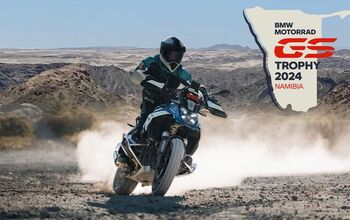
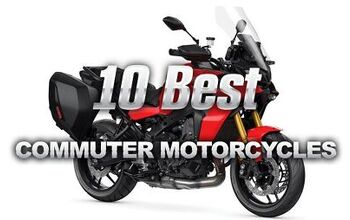
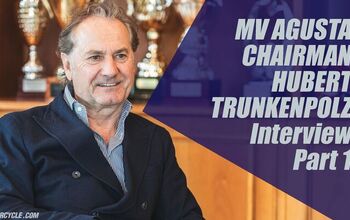
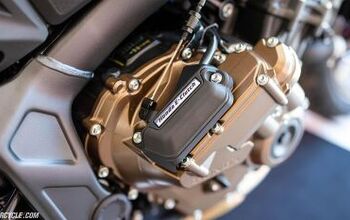

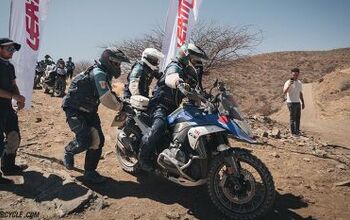




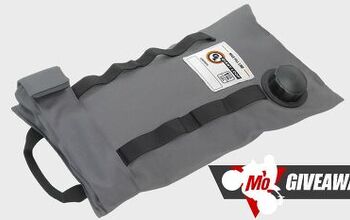


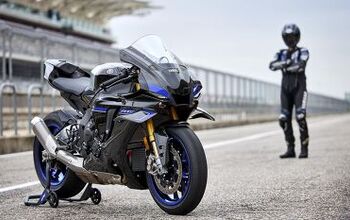




Comments
Join the conversation
I got to drive a 750 F4S in Germany. These motorcycles are show pieces and can be put in the living room as three-dimensional art.
Imtomuch,
exactly.